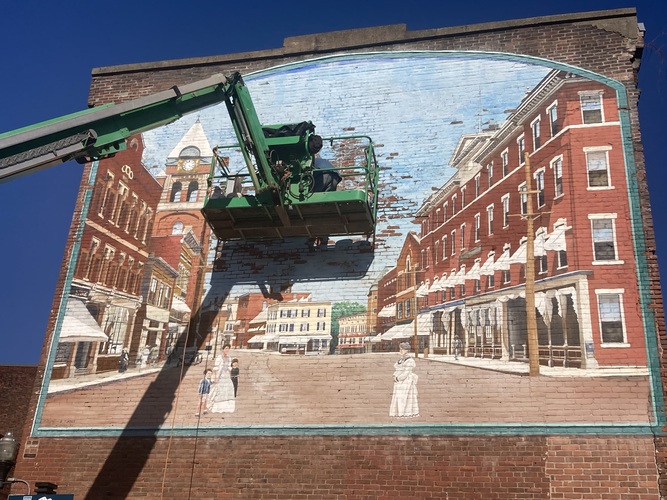BELLOWS FALLS — As it approaches a quarter century since it was originally painted, the large mural on the Flatiron Building greeting northbound travelers as they enter the Bellows Falls Square is undergoing repairs and stabilization efforts.
Based on original design sketches and paintings by local artist Ezra Veitch, the 32-foot-by-40-foot mural, created in 1999, depicts The Square as it would have looked a hundred years earlier.
The town's trolley tracks, now long gone, are visible in the painting. Some of the town's buildings look the same today; other buildings, like the Town Hall on the left side of The Square, are depicted as they used to look.
The vanishing point is centered on the building where the Rockingham Roasters coffee shop is today, at the north end of The Square. The building has been a downtown landmark for a century and a half.
The mural was completed in four weeks by muralists Cliff Clear and Bonnie Lee Turner of Art of Life. They had previously done murals on walls, buses, and even in a swimming pool.
While painting the original mural, Clear and Turner said they were delighted by the community's response, with 20 to 30 people stopping by to watch them every day as they worked.
For the painting, the wall was originally primed, a base coat was applied, followed by a second coat of the dominant blue color of the sky. Clear and Turner then rendered the foreground and buildings.
The southern sun exposure and the effects of nearly 25 years of Vermont's dramatically varied four seasons of weather have taken a toll. The mural is in need of restoration.
Working off an aerial bucket lift, a masonry restoration expert, who explained what he was doing but would not identify himself to The Commons, has begun repairing the masonry and removing loose paint and acrylic caulking to stabilize the mural in preparation for future restoration. A few trees growing up into the mural were also removed.
He said that acrylic caulking added after the mural was completed has created problems with the paint due to the caulk's lack of porosity, combined with Vermont's wet and freezing cold winter weather.
After the caulking and moisture issues are alleviated, a traditional European lime wash, matching the sky-blue color, will be used over the nearly 200-year-old brickwork on that section.
Raising money, raising questions
The original mural was the brainchild of Robert McBride, a Bellows Falls resident who moved to the village from New York City. He bought a house in the village in 1981 and moved permanently in 1994.
McBride created an arts organization, the Rockingham Arts & Museum Project (RAMP), with the goal of using the arts as one of the major economic drivers for the community.
Among dozens of large and small RAMP projects over the years, the mural on the Flatiron Building is one of the most recognizable and public.
"It was a project that really resonated with the community," McBride said.
McBride was owner of the building at the time, which put him in the position to use its large, flat south wall as a canvas. Through RAMP, he raised over $17,000 for the project.
He received over $7,000 in grants from the Windham Foundation, the Vermont Community Foundation, and the Vermont Arts Council. Another $10,000 of community donations came from businesses and individuals.
McBride said he is planning on another RAMP effort soon to raise money to restore the mural. In the meantime, RAMP is funding the stabilization work.
With more and more large and small cities and villages financing public art projects like murals, including in Springfield and Brattleboro in Vermont, and Keene in New Hampshire, McBride said "it brings up questions about creating and maintaining" public art.
He noted that grant money is often available for the initial art projects and "we want the enthusiasm for public art." But he suggested that communities ask, "Where does the money come for maintenance?"
As with the Flatiron mural, many such projects need redoing in a couple of decades. Should they be viewed as permanent?
Perhaps some could be viewed as temporary, and new artists brought in every decade or two to create a new mural on the site, McBride suggested.
With so many communities encouraging public art, these sorts of questions need to be part of the discussion from the beginning of any project, McBride said.
The Flatiron building itself has had new owners for several years.
"You can't expect future owners of the buildings to be responsible for the money to maintain the murals," McBride said.
This News item by Robert F. Smith was written for The Commons.
